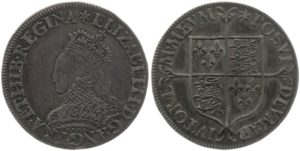Elizabeth I was always a bit of a heroine of mine. A women who ruled on her own, refused to get married, and gained the name of Gloriana for ruling over Britain’s Golden Age. There’s plenty of nostalgia and propaganda in that view, but it’s not completely untrue. It was the beginning of England as a naval power, and the work of people like Shakespeare shows the heights the arts reached in that period.
If people think of Elizabeth I now, they are likely to think of her portraits. Dressed in state splendour, heavily made up and often wearing a wig, this image of Elizabeth was highly symbolic and a key tool of political propaganda. Everything from her jewellery to the colours or embroidery on her clothes would have sent out certain messages, those that she wanted spread. Production of the portraits was very tightly controlled, and if she didn’t like the portrait that was painted it wouldn’t be used.
But these portraits were by necessity an elite item. They took a long time to paint, and they would have cost a great deal. Unlike now, when anyone with a computer can look at them, and every book about her contains several, very few people would have actually seen them. And very few would have seen her in person, usually on progress, from a distance, with her image just as carefully stage managed. There weren’t any stamps with the queen’s head, no photos or newspapers, the closest most people would come to seeing her would be on their coins. And because of this, coins were key instruments of power.
Elizabeth had a keen interest in her currency, removing the old, debased coinage of her predecessors in 1560. She issued over 20 different denominations of coins ranging from the silver halfpenny to the fine gold sovereign. This was far more than any other English ruler had issued. Further, she was the first English ruler to experiment with machine-made coins, though this was only really successful with the sixpences.
She wasn’t the first queen to be shown on coins, but they were always shown with their husband, the king. Only her sister Mary had issued coinage in her own name, with her own image, though her husband’s image did start to turn up on the coins after her marriage. What made it unique was that throughout the 44 years of her reign the coins showed only her, it was a statement that the power of the state rested in her, and was not contingent on her husband or male relatives.
It’s fascinating to wonder what people thought and felt about these coins when they were issued. As a statement of female power in a highly patriarchal society they were, at least potentially, highly controversial. Looking at a pound coin today, with the head of Elizabeth II on it, which we never even think twice about, it shows quite dramatically how much has changed.
-Claire Parker
Junior Girl
Girls Museum Inc.

